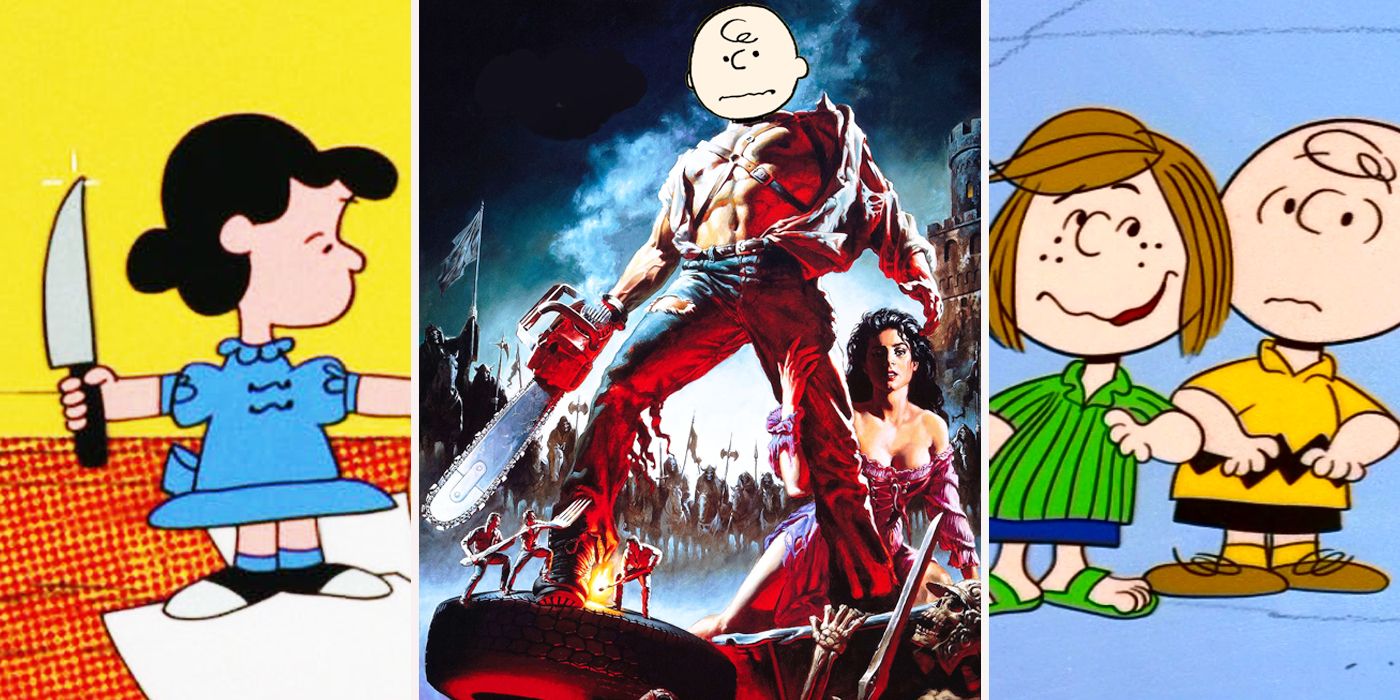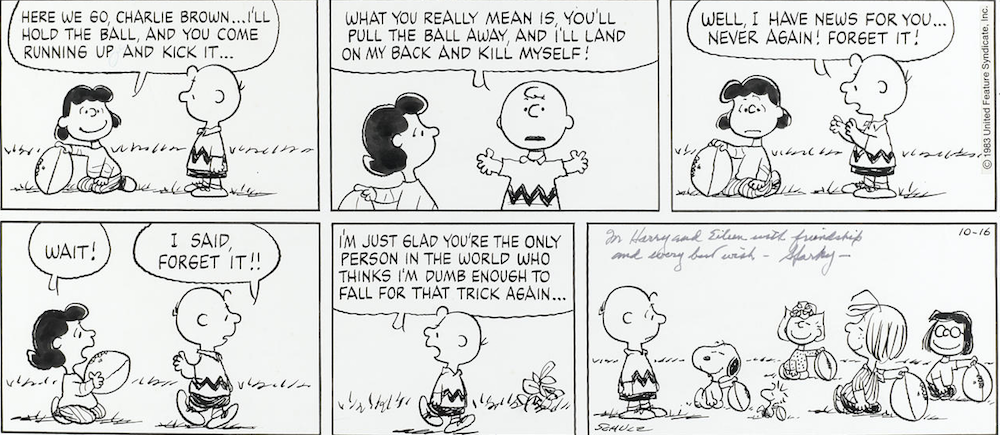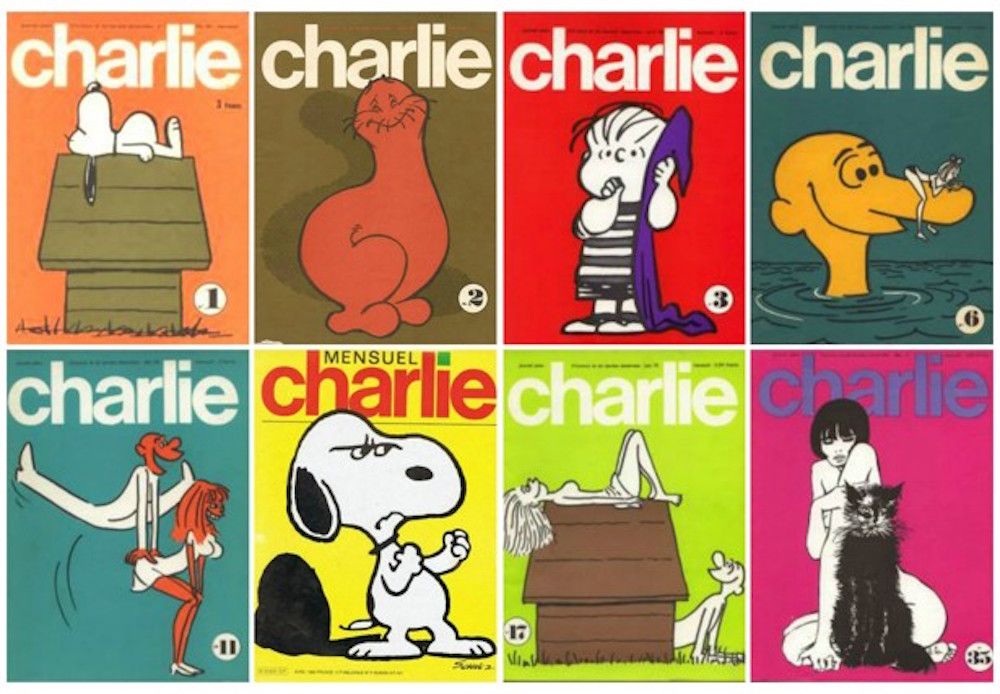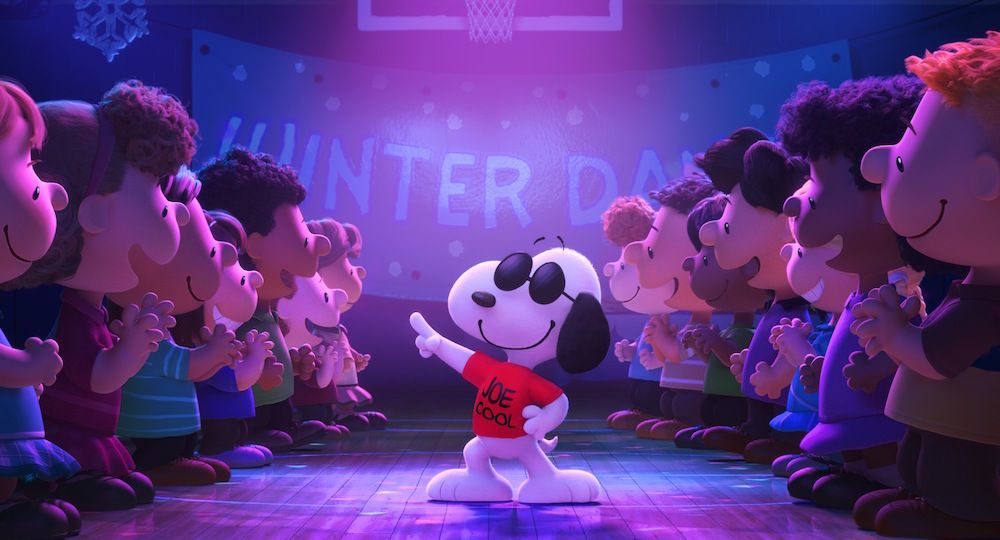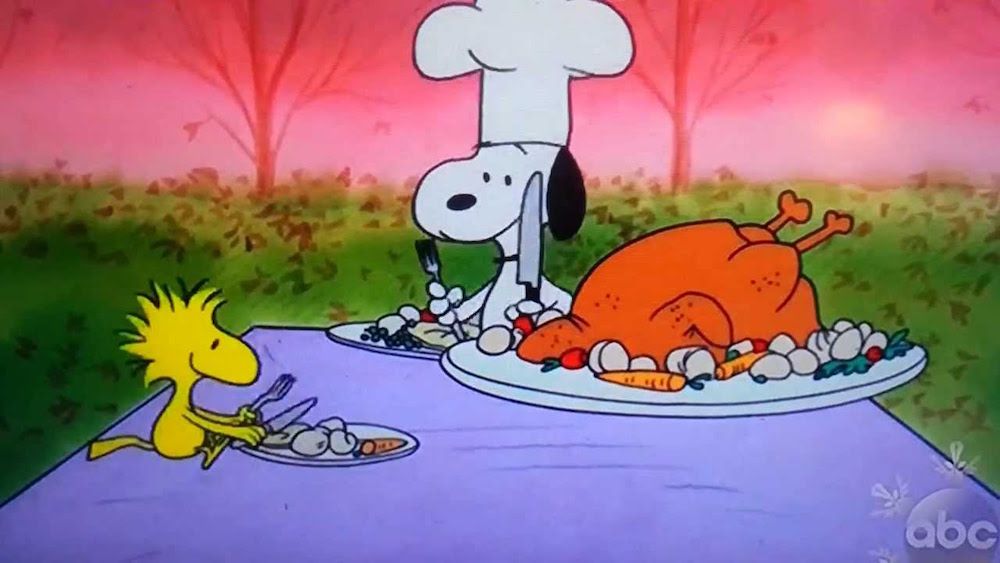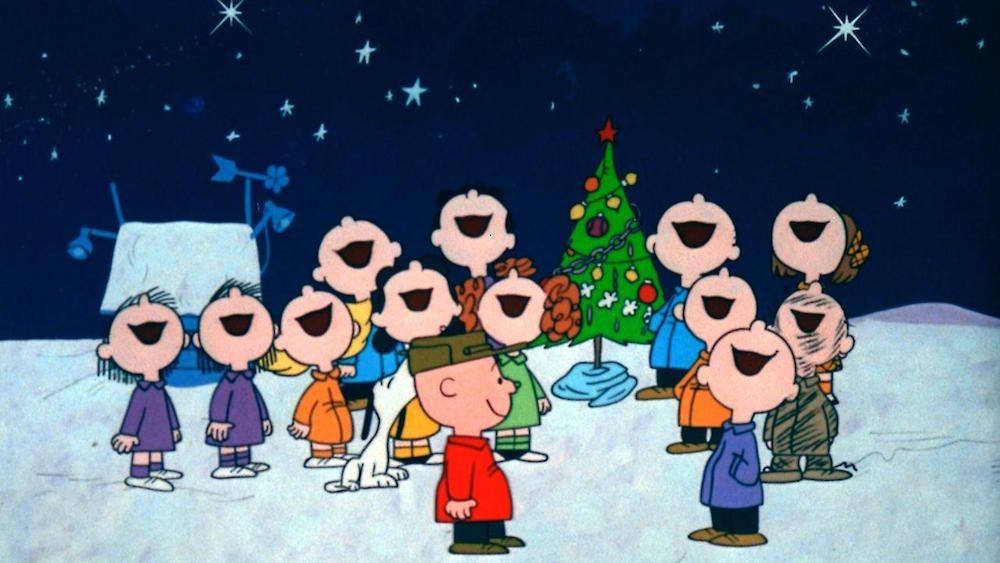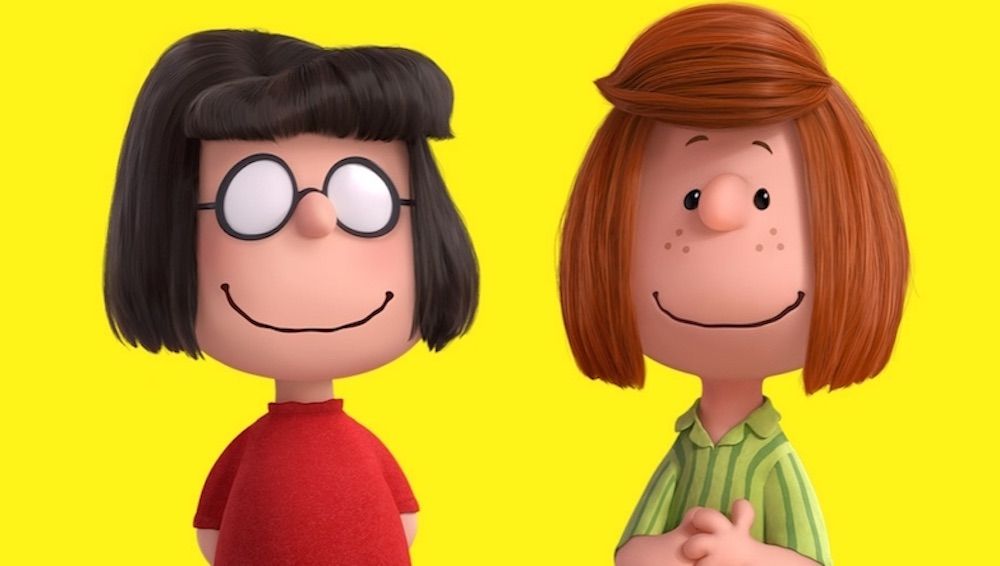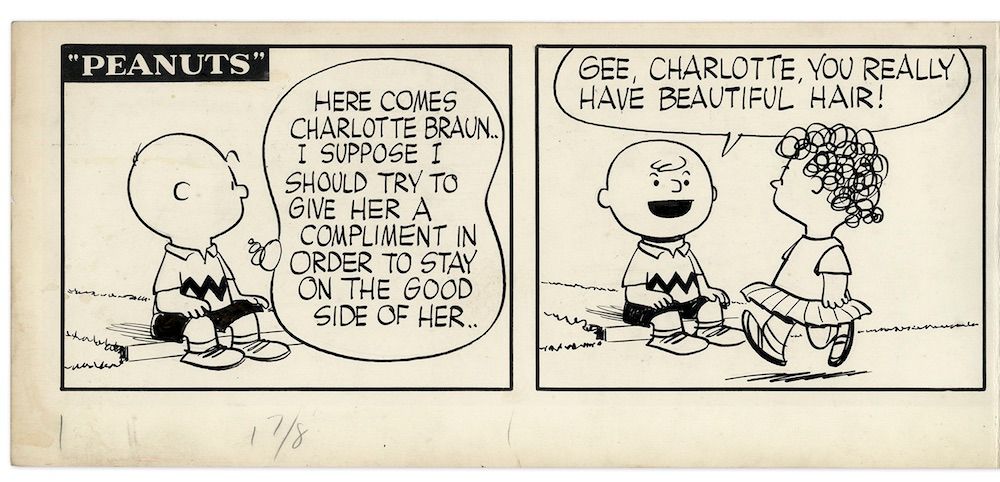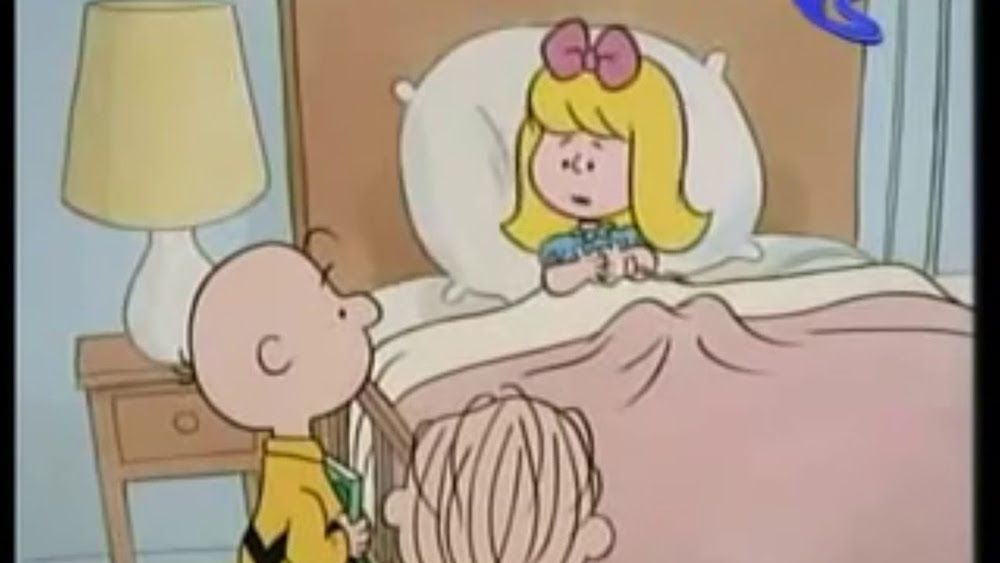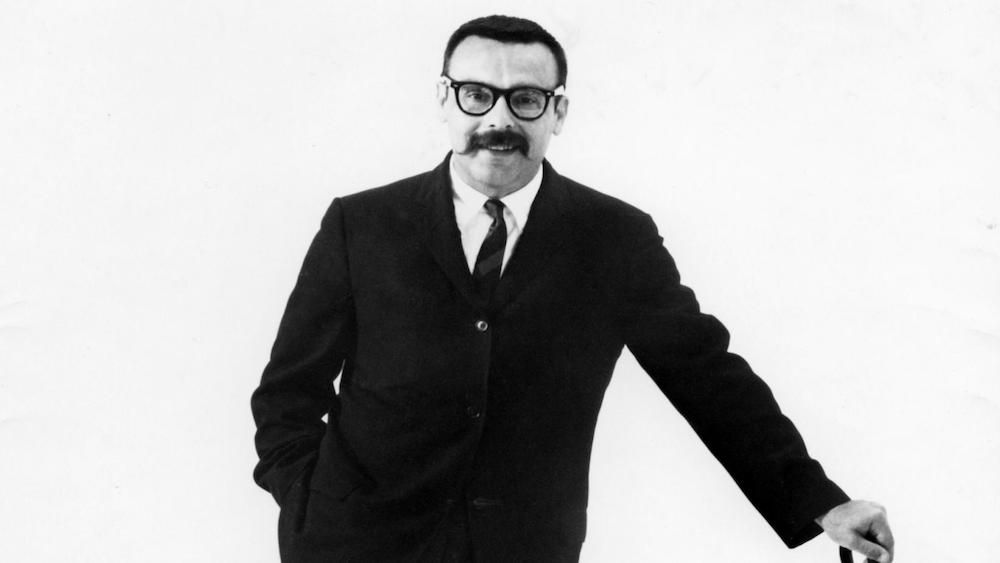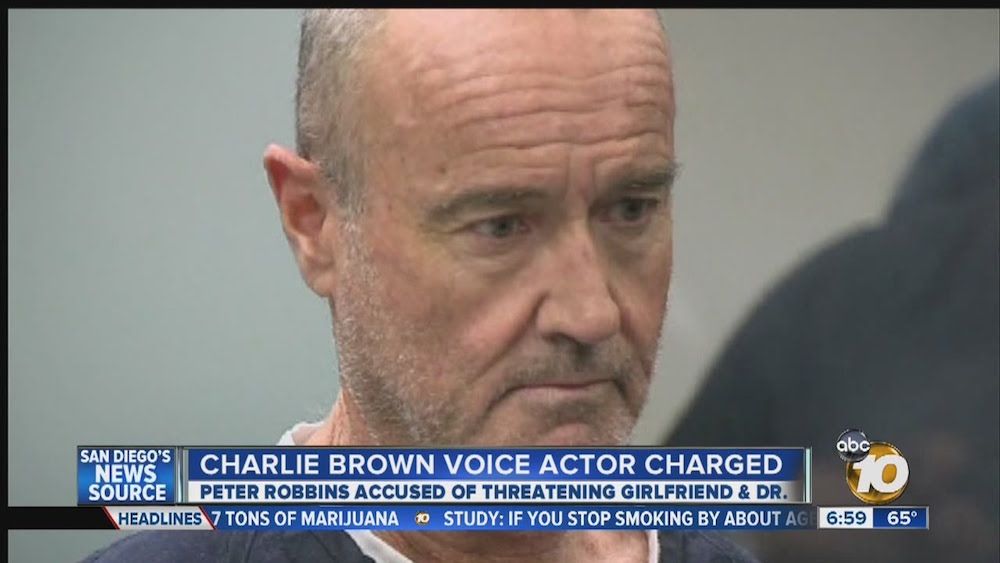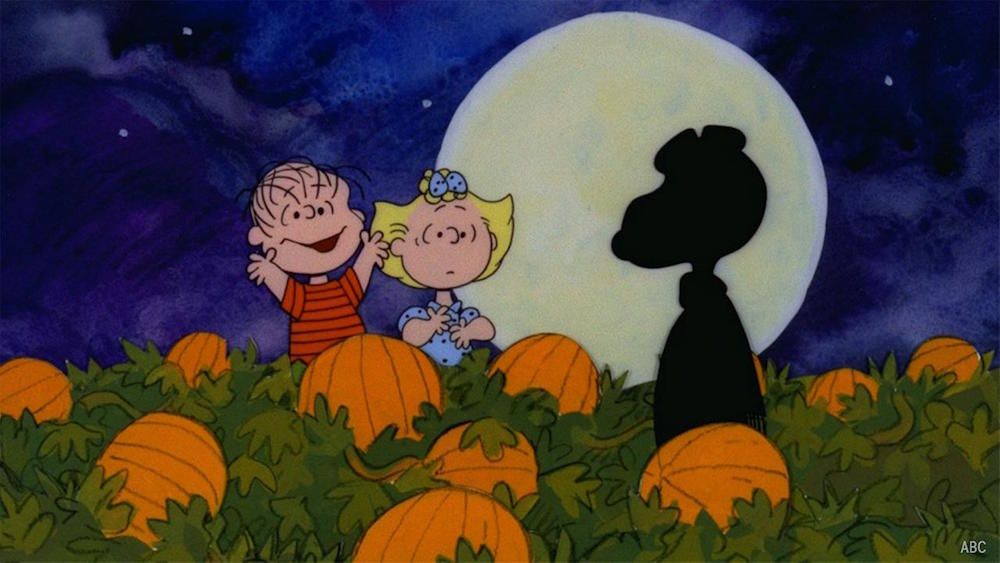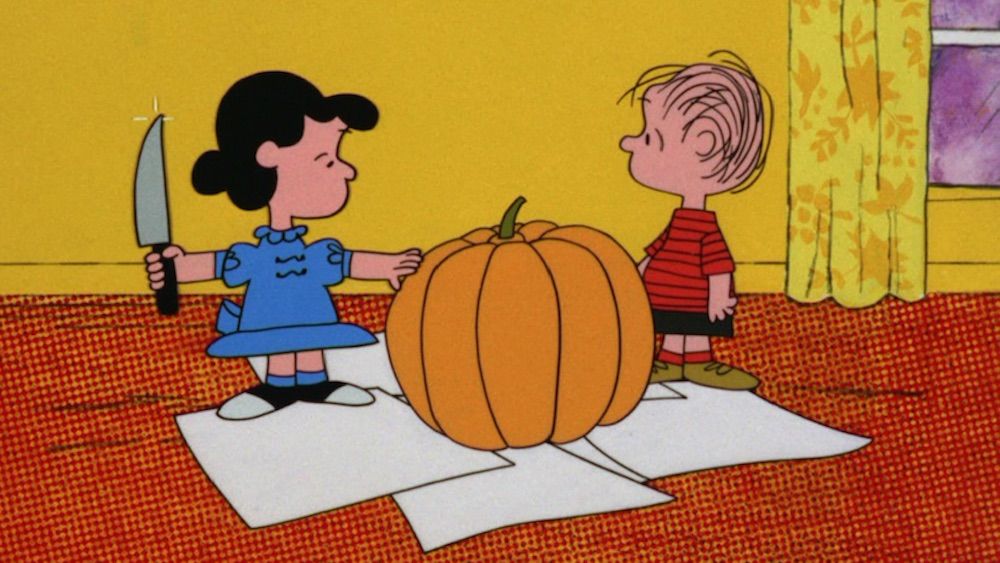Considered one of the most influential and beloved comic strips of all time, Peanuts ran from October 1950 to February 2000 and has continued to charm audiences in the form of various television specials, a stage musical, and the animated 2015 film. Detailing the struggles of a group of children, the focus has always remained on the central character Charlie Brown, whose relatable "the world is out to get me" outlook on life has kept fans hooked. Readers relied on the unrelenting hope that he would finally kick that darn football, despite knowing deep down that Lucy would snatch it away at the last second every time he got close.
During its "golden age" in the 1960s, the comic introduced influential characters such as Franklin, Peppermint Patty and Snoopy, who has gone on to become a phenomenon in and of himself, and commented on topics of race, religion, and gender roles. The television specials, especially the holiday-themed stories, continue to be broadcast every year in front of captivated audiences. In their fascination, fans have uncovered secrets behind Schulz's legacy and developed theories regarding certain storylines and characters. Below is a collection of 15 secrets, controversies, and theories about the members of the beloved Peanuts gang.
15 ACCIDENTAL RACIST
Franklin Armstrong, the first and only African American Peanuts character, made his comic strip debut on July 31, 1968. During this time, the U.S was beginning a slow process of desegregation. Though steps had been taken, controversy still surrounded issues regarding whether black and white people should attend the same schools or use the same restrooms. Franklin's inclusion in the comic came about after a correspondence between Charles Schulz and Harriet Glickman, a retired schoolteacher concerned about race relations shortly after Martin Luther King Jr.'s assassination.
Schulz was initially hesitant to introduce the character due to fear of being patronizing during a tense time. A friend of Glickman's assured Schulz that including the character among the established Peanuts gang would "suggest racial amity" in a casual setting. Schulz's decision to have Franklin be a friend and classmate of Charlie Brown was met with resistance from editors who feared backlash. Nevertheless, Schulz proceeded with caution as he continued to feature Franklin in more comics, making him a guest of A Charlie Brown Thanksgiving.
14 DREAD ONE DAY AT A TIME
Despite the lovable nature surrounding the Peanuts characters, their often melancholy outlook on life was hard to ignore. Charlie Brown, despite being the main character of the comic and various TV specials, was especially bleak. Used to being the butt of a joke or receiver of a taunt, the character was left with the firm belief that the world was against him.
The 1950s comics focused on the idea that society was made of children who were cruel to each other, leading to frequent conflicts. They also suggested quiet contemplation about life would come to reveal all hopes would end in miserable failure. Perhaps Snoopy's tendency to live in his fantasy world was meant to be a lesson and the best way to avoid life's problems it to ignore them entirely.
13 MATURE READERS ONLY
Careful when it came to provocation, Schulz couldn't foresee that his creations would inspire the offensive nature of "Charlie Mensuel" and "Charlie Hebdo," two French magazines known for their raunchy, highly satirical content. "Charlie Mensuel," which ran from 1969-1986, featured historical cartoons, while "Charlie Hebdo" was a reinvention of the previous publication "Hara-Kiri Hebdo" that was banned in 1970 for mocking the death of Charles de Gaulle.
Though both magazines take their name from the popular down-on-his-luck character, they didn't do so in reverence. Despite featuring various Peanuts strips in their pages and the popular characters on their covers, Mensuel and Hebdo focused more on explicit sexual innuendo and politically-incorrect buffoonery. On one of its covers, Mensuel used the image of Snoopy's doghouse and featured a woman reclining on top while a man gazes lustfully up at her rear-end.
12 SELF-ABSORBED SNOOPY
The delightful four-legged companion of Charlie Brown has grown in popularity since his humble beginnings in 1950. While many of the characters either succumb to or remain defiant of the weight of the world on their shoulders, Snoopy is blissfully unaware of its problems. Some argue his unwillingness to be an active participant in his fellow characters' struggles show him to be more of an outcast rather than faithful friend.
Determined to define himself as more than just a dog, Snoopy invents his heroic persona as a WW1 Royal Flying Corps Ace and, in the 2015 movie, an alter-ego as a popular college student named "Joe Cool." Regarding the character's actions, Schulz stated, "he has to retreat into his fanciful world in order to survive." It's unclear whether Snoopy is stubbornly refusing to live in the real world or is ignorant to recognize life outside of his fantasy.
11 WOODSTOCK THE CANNIBAL
Feathered friend of Snoopy, Woodstock made his first appearance as an unnamed bird on April 4, 1967. Named in 1970 after the summer music festival, the giddy sidekick has come under scrutiny by eagle-eyed Peanuts fans. In the original version of A Charlie Brown Thanksgiving, Snoopy is seen carving a turkey and shockingly, offers a piece to Woodstock, who readily accepts it.
Apparently seeing a member of his fowl family cooked up and served didn't phase little Woodstock one bit. He even challenges Snoopy to the wishbone and in the struggle, manages to be victorious. Editorial override allowed for the grisly scene to remain in the special until ABC received the rights to broadcast. They cut several scenes which allowed for more commercials to air, instead leaving Snoopy and Woodstock to chow down on pumpkin pie.
10 NO CHRISTMAS FOR CHARLIE BROWN
During the holiday season, tradition brings many people to gather around the television to watch endless television specials. Despite airing every December for over 50 years, it may come as a shock to Peanuts fans that A Charlie Brown Christmas almost wasn't produced.
At the time, no one believed Schulz's story would make for good TV and desperate to recover from a failed documentary on the author, producer Lee Mendelson and the team cranked out an outline for a two-minute segment. The final product was considered a disheveled mess by CBS, which was concerned about the slow-paced action and overly religious tone. Fearing this was the death of Charlie Brown, the team was surprised by the positive reviews and the special won a Peabody and Emmy Award.
9 A QUESTION OF REPRESENTATION
Above all else, Peanuts is about relationships: Lucy's unrequited love for Schroeder, Sally's adoration of Linus, and Charlie Brown's endless pursuit of the Little Red-Haired Girl. One relationship that has remained undefined, intriguing fans for years, is that of Peppermint Patty and Marcie. Was their bond simply friendly or something more?
In the original comics, both characters have crushes on Charlie Brown but since then, there have been hints and strong beliefs that Peppermint Patty and Marcie are concealing romantic feelings for each other. Instead of one character being an unresponsive receiver of affection, these characters have genuine conversations about their emotions. They are the female equivalent of Charlie Brown and Linus; one gripped with anxiety while the other offers wise words of comfort. Various theories about the nature of their relationship have been made on SNL, Family Guy, and parodied on Robot Chicken.
8 GOOD OL' CHARLOTTE BRAUN
On November 30, 1954, Schulz introduced a female counterpart to Charlie Brown. Loud-mouthed, highly-opinionated Charlotte Braun bulldozed her way onto the pages of Peanuts with her boldly typed conversations, but her story was short-lived. After receiving negative feedback from fans regarding the character, Schulz literally gave her the chop in February of 1955.
Responding to one letter in particular, written by Elizabeth Swaim, the author left a suggestive sketch beside his signature. Writing "you... will have the death of an innocent child on your conscience...", Schulz drew a image of Braun with an axe protruding from her head. The letter, along with the grisly image, is now kept in the United States Library of Congress. The character's combative personality was later transferred to the more popular Lucy during the mid-1950s.
7 WHY, CHARLIE BROWN, WHY
Why, Charlie Brown, Why?, which aired on CBS in March 1990, had the characters encounter the difficult subject of cancer. Charlie Brown and Linus discover their classmate Janice Emmons has been diagnosed with leukemia. Both children grow aware of the disease and its seriousness as Janice discusses her chemotherapy; Charlie Brown at one point asks if she's going to die.
A deeply distraught Linus, known for seeing the bright side to every problem, struggles to come to terms with what's happening to his new friend. He becomes Janice's defender when, after losing her hair and forced to wear a cap, she becomes the target of a bully's harsh comments. When all hope appears to be lost, Janice returns from the hospital in the spring, eager to show her now flowing hair to Linus, who is overjoyed by her recovery.
6 IT'S THE GREAT PUMPKIN
Responsible for scoring seventeen Peanuts specials and writing the music for the 1969 feature film A Boy Named Charlie Brown, legendary composer Vince Guaraldi experienced a truly "good grief" moment while composing "The Great Pumpkin Waltz." Deciding to take a break, Guaraldi was preparing to take a shower when he became distracted by a noise outside. Deciding to investigate, the composer ended up locking himself out of his house.
Sans a towel, the composer was left in an awkward predicament. The situation was only made worse when the police arrived and caught him trying to break back into his home through a second-story window. Thankfully, Guaraldi had a good sense of humor and when stopped by the police, announced, "Don't shoot... I'm the Great Pumpkin!"
5 GOOD GRIEF
Peter Robbins voiced Charlie Brown in several 1960s TV specials until he was 13 years old. His trademark "AUGH!!", first used in It's the Great Pumpkin, Charlie Brown, has since continued to be used in later specials. In 2013, the child actor ran into trouble with the law after pleading guilty to threatening his ex-girlfriend and her plastic surgeon.
Violating his probation, he was sentenced to four years in jail. In December 2015, Robbins was sentenced to four years and eight months for making criminal threats, allegedly hiring someone to kill Sheriff William Gore. According to the Los Angeles Times, the actor told the judge his actions were due to a diagnosis of paranoid schizophrenia and bipolar disorder. He remains incarcerated at the California Institution for Men.
4 FEELING FERGALICIOUS
Not even ten years old yet, a young Stacey Ferguson, aka Fergie, voiced Sally Brown from 1983-1985. Her voice can be heard in The Charlie Brown and Snoopy Show and in the special Snoopy's Getting Married. The little starlet then went on to become the longest cast member of Kids Incorporated from 1984-1989.
Before being invited to become a member of The Black Eyed Peas in 2002, Fergie was part of the female trio Wild Orchid, whose musical career ended in commercial failure. After leaving the group in 2001, she rose to success and released her first solo-album "The Dutchess" in 2006. These past few years, Fergie has gone on to release the single "M.I.L.F.$" in 2016 featuring celebrity mothers, her second album "Double Dutchess" in 2017, and sung a less-than-patriotic version of the national anthem.
3 PEANUTS VS. THE EVIL DEAD
No childhood show is safe from wild conspiracy theories and Peanuts is no different. A notable aspect of the comic and its specials is the lack of parental supervision. It's been suggested that the reason there are no adults around is because they've all been eaten by a vengeful god who's taken the form of a giant pumpkin.
Fans believe the Halloween special is actually the story of a monster who must devour anyone over the age of ten. As if that wasn't gruesome enough, the theory goes on to suggest that innocent Linus is luring his friends into the pumpkin patch as sacrifices. To explain the reason for the season, it's also believed he was supposed to read from the Necronomicon, summoning demons to possess the characters only to be defeated by Snoopy under the guise of a "World Famous Exorcist."
2 CHEATED OUT OF TRICKS-OR-TREATS
While the Peanuts cartoons have retained a light-hearted nature, it's believed Schulz wanted to take a darker turn when it came to the Halloween special. Instead of depicting children eager to go trick-or-treating as seen in the established special, it's believed the original intention was to have it be a two-hour slasher flick featuring Lucy as the deranged serial killer.
The opening scene would feature Lucy in an insane asylum, declaring she's a fellow psychiatrist of the institution. While being restrained by law enforcement, she would slowly reveal in the form of a flashback how she murdered everyone. The flashback would take the form of the opening scene audiences are familiar with, showing Lucy stabbing a pumpkin in preparation for carving, only this time unleashing the malevolent spirit of the Great Pumpkin who demands blood be spilt as payment for the slaughter of innocent pumpkins each Halloween.
1 MY ANXIETIES HAVE ANXIETIES
It's clear that many of the Peanuts gang struggle with their personal demons: Charlie Brown and his lack of self-confidence, Lucy and her anger issues, Snoopy's escapism. Fans of the comics are aware of the emotional turmoil Schulz was facing while creating the beloved characters, struggling with depression and a complicated romantic life. These two contributing factors have led to the general assumption that each character is a representation of a real-life personality disorder.
Beginning with the main character, it's overwhelmingly obvious that Charlie Brown is suffering from depression. The (un)official diagnosis for him is Avoidant Personality Disorder, characterized by his obsessiveness over his shortcomings and dominating insecurities. Lucy's aggressive temperament is a sign of Borderline Personality Disorder; having dramatic changes in mood and being prone to angry outbursts. Marcie and Schroeder are antisocial, keeping mostly to themselves and only interacting with others when necessary.

